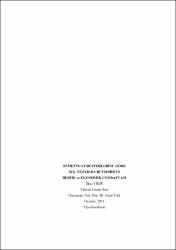| dc.contributor.advisor | Taş, Barış | |
| dc.contributor.author | Yiğit, İlker | |
| dc.date.accessioned | 2015-01-15T12:01:35Z | |
| dc.date.available | 2015-01-15T12:01:35Z | |
| dc.date.issued | 2011-06-06 | |
| dc.date.submitted | 2011-06-06 | |
| dc.identifier.citation | Yiğit İlker ''Temettuat Defterlerine Gore Xıx. Yuzyılda Beysehđr’đn Beseri ve Ekonomik Coğrafyası'' '' Regard Of Temettuat Derfters Human And Economic Geography Of Beysehir İn XIX. Century'' Afyon Kocatepe Üniversitesi Afyonkarahisar 17.06.2011 | en_US |
| dc.identifier.uri | https://hdl.handle.net/11630/1538 | |
| dc.description.abstract | Basbakanlık Osmanlı Arsivi’nde bulunan 1840 ve 1845 yıllarına
ait Temettuat defterleri ile 1871 ve 1896 yılına ait Konya Vilayet salnameleri, 1922
yılına ait “Türkiye’nin Sıhhi Đçtimai Coğrafyası, Konya Vilayeti” isimli eser ve 1935
yılı nüfus sayımı temel alınarak hazırlanmıstır.
Çalısma coğrafyacılar tarafından üzerinde çok az arastırmanın yapıldığı tarihi
coğrafya alanında yapılan ilk yüksek lisans tezidir. Yukarıda ifade edilen
kaynaklardan elde edilen bilgiler haritalanmıs ve analiz tablolarıyla konu
zenginlestirilmis ve daha önce yapılan çalısmalarla desteklenmis ve coğrafi bir
sentez olusturularak bu çalısma tamamlanmıstır.
Beysehir ve çevresi sahip olduğu uygun kosullar sayesinde Đlkçağ’dan
günümüze yerlesmeye sahne olmus bir alandır. Bunda iklim, yer sekilleri, verimli
tarım alanlarının varlığı ve su kaynakları önemli faktörler olarak karsımıza çıkar.
Çalısmada, arastırma dönemi olarak tespit ettiğimiz zaman dilimi içerisinde
Beysehir Kazası’nın nüfusu % 73 artarak, 1840 yılında 11.375 olan nüfusu 1935
yılında 19.722 olmustur.
Sahanın ekonomik özellikler içerisinde tarım, hayvancılık, sanayi, ve ulasım
faaliyetleri de ortaya konmustur. Günümüz Anadolusu’nda olduğu gibi -Osmanlı
ülkesinin genelinde olduğu üzere- hakim ekonomik faaliyet tarım ve hayvancılıktır.
Ekonomik faaliyetler içinde sanayinin payı oldukça azdır. Bu sanayi faaliyetleri de
çoğunlukla tarımsal hammaddeleri kullanmaktadır.
XIX. yüzyılda Beysehir tarımsal faaliyetler ile uğrasanlar, tahıl, çesitli meyve
ve sebze üretimi yapmaktadırlar. Sanayi sektörü içinde değerlendirilenler,
marangozluk, ekmekçilik, nalbantlık gibi faaliyetler ile mesgul olmaktadırlar. Hizmet
sektöründe faaliyet gösterenler ise, dini ve idari görevler, “amelelik”, “ırgatlık”, adı
altında toprağı olmayan insanların yapmıs olduğu isçilik faaliyetleri yer almaktadır. | en_US |
| dc.description.abstract | This study is prepared on the base of the profit notes (temettuat), belonging
to the dates of 1840 and 1845 in the Ottoman Archives, Konya State Salnames
belonging to the years of 1871 to 1896, 1922’s “Turks sanitory and social
Geography, Konya State” (Türkiye’nin Sıhhi Đçtimai Coğrafyası, Konya Vilayeti )
work and 1935’s census records.
This study was the first master thesis studying the historical geography,
which many geographers do not work on. The data obtained from the named
documents above was charted and enriched with the help of analysis tables. Lastly,
this study was supported by the previous studies and completed with a geographical
synthesis.
Beysehir and the surrounding region have been suitable places for settlement
from the antiquity age to present. We can list the factors behind the settlements as
climate, geographical formations, fertile farming lands and water resources.
Constituting the subject of this study, the period between 1840 and 1935, the
population in the district of Beysehir increased by 73% increasing from 11,375 in
1840 to 19,722 in 1935.
Agriculture, stockbreeding, industry and transportation can be considered
among the economic properties of the region. As in today’s Anatolia, Ottoman’s
general economic activities are agriculture and stockbreeding. There are very few
industries, which run agricultural raw materials in the economic activities.
In the 19th century Beysehir, the people working in agriculture generally grew
various fruits and vegetables. Carpentry, bakery, and blacksmith were the industrial
activities of the people. The people who are not landowners, engaged in religious and
administrative tasks like “employee” (amelelik) and “laborer” (ırgatlık) were in the
service sector. | en_US |
| dc.language.iso | tur | en_US |
| dc.publisher | Afyon Kocatepe Üniversitesi, Sosyal Bilimler Enstitüsü | en_US |
| dc.rights | info:eu-repo/semantics/openAccess | en_US |
| dc.subject | Beyşehir | en_US |
| dc.subject | Tarihi Coğrafya | en_US |
| dc.subject | Tarih | en_US |
| dc.subject | Coğrafya | en_US |
| dc.subject | Temettuat | en_US |
| dc.subject | Beşeri ve Ekonomik Coğrafya | en_US |
| dc.title | Temettuat defterlerine göre XIX. yüzyılda Beyşehir’in beşeri ve ekonomik coğrafyası | en_US |
| dc.title.alternative | Regard of temettuat derfters human and economic geography of Beysehir in XIX. century | en_US |
| dc.type | masterThesis | en_US |
| dc.department | Afyon Kocatepe Üniversitesi, Sosyal Bilimler Enstitüsü, Coğrafya Anabilimdalı | en_US |
| dc.authorid | TR23110 | en_US |
| dc.relation.publicationcategory | Tez | en_US |



















